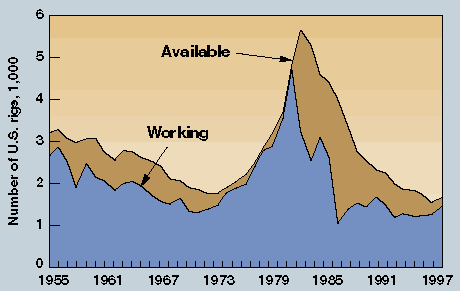What's happening in drilling
Profits up, rig counts up, oil prices hovering at $20/bblThe Organization of Petroleum Exporting Countries (OPEC) has recently agreed to raise its crude oil production ceiling by just under 10%. According to the U.S. Department of Energy Information Administration (EIA), OPEC fact sheet, "The increase was allocated on a pro rata system where most country quotas were increased by the same percentage. Algeria received a slightly larger increase because it received a smaller increase the last time quotas were set. However, OPEC crude oil production is not expected to increase by 10% since many countries are already producing at maximum capacity. Bottom line: We expect an increase in OPEC crude oil production (excluding any change in Iraqi crude oil production) of about one half million bpd. This should lead to a near-term decline in oil prices, but not a collapse in oil prices." With this in mind, let's examine some of the oil and gas fundamentals driving oil prices. According to the Federal Reserve Bank of Dallas, by 1995, the oil and gas industry had achieved efficiencies that allowed it to thrive at $17/bbl oil and $1.70/Mcf natural gas. So higher prices of '96 and '97 ($20/bbl oil and $2.00/Mcf gas) have created huge cash flows. Oil and gas producers are making a determined effort to drill these profits back into the ground. When compared to the prior year, the number of oil and gas wells drilled was up 21.8% in '96 and 17.7% in '97. Total footage drilled and the number of working rotary rigs has also increased. A major dilemma facing the oil and gas industry is how to cope with the increases in oil field capacity and at what cost. In 1982, Reed Tool reported 5,644 U.S. rigs available and ready for work, but only 3,225 were active. By 1986, only 1,052 rigs were working of 3,993 available. Last year (1996), Reed Tool found only 1,649 rigs were available for work, and 1,263 were working. In 1997(data through Nov.) the gap between working and available rigs had narrowed even more (1,665 available with 1,447 active). Offshore rig activity in the Gulf of Mexico has been spurred not only by higher gas prices, but also by new opportunities in the deep waters and sub-salt regions.
Oil country tubular goods (OCTG) are in high demand due to increased drilling rig activity. Over the past two years, strong oil and gas fundamentals have driven the U.S. active drilling rig count upward over 20% per year. Although the expected rate of increase in rig count should slow due to people and equipment constraints, it is expected to continue increasing over the next several years. Continued strong oil and gas fundamentals encourage E&P companies to drill more wells. Thus pipe consumption per rig should drive pipe demand and price upward. Excess drill pipe has finally been used up and the market is now better balanced between supply and demand. Users accustomed to lower prices due to excess supply are simply adjusting to the higher prices. New record for deep real-time MWD triple transmission. Early this fall, Anadrill, a subsidiary of Schlumberger Oilfield Services, broke its own world record for the deepest real-time measurement-while-drilling (MWD) triple combination transmission while working for Phillips China Inc.'s extended-reach drilling project in the South China Sea. In Phillips' Xijiang 24-3-A14 well, Anadrill acquired and transmitted real-time resistivity, density and neutron data at 29,875 ft, breaking the previous record by more than 2,000 ft. The company used its PowerPulse MWD, Compensated Dual Resistivity, and Azimuthal Density Neutron tools to obtain and relay the measurements. The completion also set a world record for extended-reach drilling, with horizontal displacement of more than 5 mi (26,452 ft) from Phillips' Xijiang 24-3 platform, 80 miles south of Hong Kong. Deepwater drilling fleet to double in next three
years. The size of the world's deepwater drilling fleet, currently at 35
drillships and semisubmersibles with the ability to drill in water depths of 2,600 ft or
more, is set to double in the next three years. Global Marine Inc. has 13 rigs undergoing
upgrades in shipyards, and 23 are on order as newbuilds or conversions. Global noted that
several recent contracts for newbuilds suggests "either aggressive assumptions
regarding ultimate construction costs or a willingness to accept marginal rates of return in
consideration of longer contract terms." Copyright © 1999 World
Oil |
- Applying ultra-deep LWD resistivity technology successfully in a SAGD operation (May 2019)
- Adoption of wireless intelligent completions advances (May 2019)
- Majors double down as takeaway crunch eases (April 2019)
- What’s new in well logging and formation evaluation (April 2019)
- Qualification of a 20,000-psi subsea BOP: A collaborative approach (February 2019)
- ConocoPhillips’ Greg Leveille sees rapid trajectory of technical advancement continuing (February 2019)




